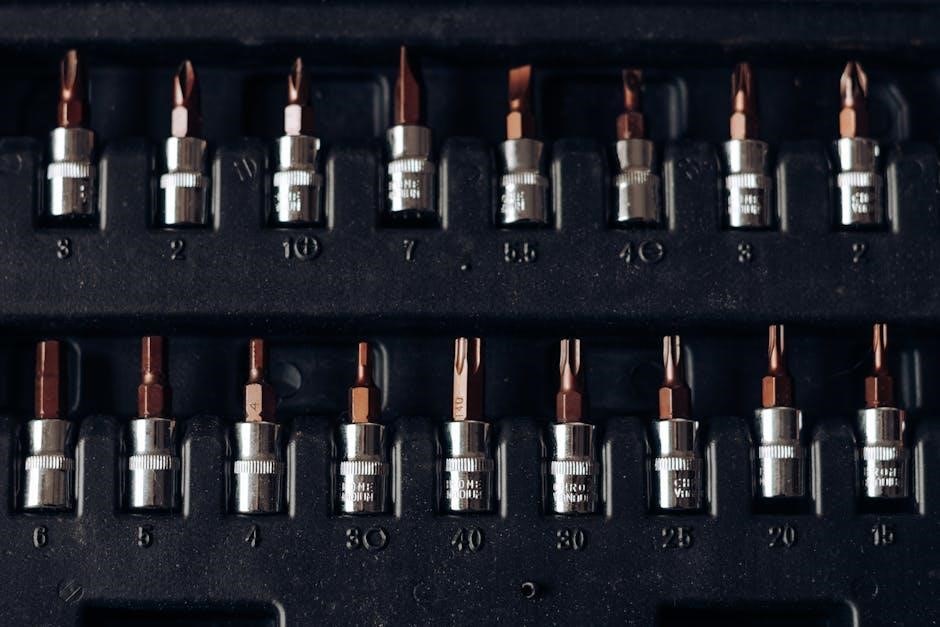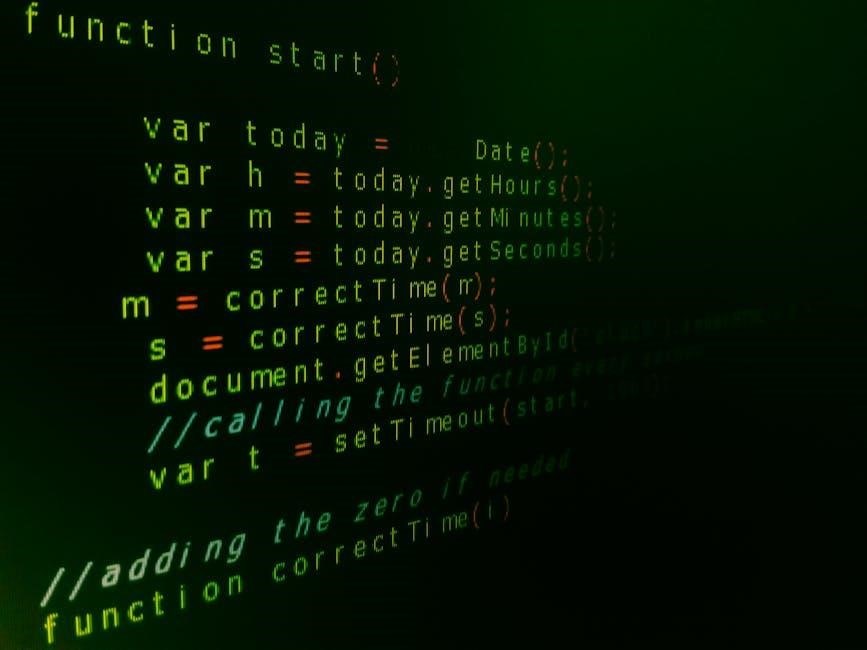
dsc pc5010 programming manual
This manual provides comprehensive guidance for installing, configuring, and programming the DSC PC5010 control panel. It covers keypad and PC-based programming, remote options, and essential security features.
1.1 Overview of the DSC PC5010 Control Panel
The DSC PC5010 is a powerful control panel designed for advanced security systems. It supports keypad programming, PC-based configuration via DLS software, and remote programming options. The panel offers programmable zones, PGM outputs, and customizable access levels. It integrates seamlessly with GSM-GPRS communicators and is compatible with other systems like Paradox. Its flexible design ensures robust security solutions for various applications.
1.2 Importance of Proper Programming
Proper programming ensures optimal functionality, security, and reliability of the DSC PC5010 system. Incorrect settings can lead to reduced efficiency or security breaches. Accurate configuration of zones, access levels, and PGM outputs ensures the system meets specific security needs. Proper programming also guarantees compliance with safety standards and allows for seamless integration with other devices. It ensures the system operates efficiently, providing robust protection and peace of mind for users.

Installation and Basic Setup
Installation involves connecting hardware and configuring settings. Proper setup ensures system functionality and compatibility. Follow guidelines for wiring and initial startup to guarantee optimal performance and security.
2.1 Hardware Requirements and Compatibility
The DSC PC5010 requires specific hardware for installation, including compatible control panels and communication modules. Ensure all components are verified for compatibility to avoid system malfunctions. Proper hardware setup guarantees seamless integration with GSM-GPRS communicators and other Paradox systems. Refer to the manual for detailed compatibility lists and specifications to ensure optimal performance and security.
2.2 Initial Configuration and Startup
Begin by entering the master code to access the programming menu. Program user codes and set the time and date by pressing *6, followed by the master code and 1. Use the DLS software for PC-based setup, ensuring all hardware is connected properly. Follow the manual’s step-by-step guide to complete the initial configuration successfully and avoid potential issues during startup.
Programming the DSC PC5010
Program the DSC PC5010 via keypad or PC using DLS software. Configure user codes, zones, and advanced settings. Remote programming options are also available for convenience.
3.1 Programming via Keypad
Programming the DSC PC5010 via the keypad is a straightforward process; Enter the master code to access programming mode. Navigate through menus by pressing keys sequentially. Program user codes, zone configurations, and PGM options. Use the keypad to set time, date, and system settings. Follow the manual’s step-by-step guide for precise instructions. Ensure all entries are made one key at a time for accuracy.
3.2 Programming via PC using DLS Software
Programming the DSC PC5010 using DLS software offers advanced configuration options. Connect the control panel to your PC and launch the DLS application. The software provides a user-friendly interface for programming user codes, zone settings, and PGM options. It allows for detailed system customization and efficient management of security features. Follow the software prompts and manual guidelines to ensure accurate programming and system optimization.
User Codes and Access Levels
User codes and access levels are essential for securing the system. Each user can have a unique code with specific permissions, ensuring controlled access to system functions.
4.1 Master Code and User Codes
The Master Code is the primary code for the system, set by the installer. User codes (01 to 32) can be programmed for individual access. Each code grants specific permissions, ensuring secure access. The Master Code must be entered to program or modify user codes. Regularly updating the Master Code enhances security. All codes are programmed via the keypad or DLS software, following the outlined procedures in the manual for proper configuration and system functionality.
4.2 Assigning Access Levels
Access levels determine user permissions, ensuring restricted functionality for non-administrative users. Levels are assigned during programming, allowing administrators to control access to sensitive features. Each level defines what actions a user can perform, such as arming, disarming, or viewing system status. Proper assignment of access levels enhances security by limiting unauthorized access to critical system functions, ensuring only authorized personnel can make changes or view sensitive information.

Advanced Programming Features
Advanced features include zone configuration, PGM options, and integration with GSM-GPRS communicators, enabling customizable security solutions and enhanced system functionality for tailored applications.

5.1 Zone Configuration and Settings
Zone configuration is crucial for customizing system responses. Users can assign zones, adjust sensitivity, and set entry/exit delays. The PC5010 supports various zone types, including entry/exit, burglary, and fire zones. Settings can be tailored to specific security needs, ensuring optimal protection. Refer to the manual for detailed steps on configuring zones and adjusting parameters for enhanced system performance and reliability.
5.2 PGM (Programmable Output) Options
PGM outputs allow customization of system responses. These outputs can be programmed to trigger external devices like lights or alarms. Configurations are set in sections 009, 010, and 011, enabling precise control over activation events. Each PGM output can be tailored to specific scenarios, enhancing system functionality. Proper programming ensures reliable operation, making PGM options a key feature for advanced security setups in the DSC PC5010 system.

Troubleshooting and Maintenance
This section covers diagnosing and resolving common issues with the DSC PC5010. It includes troubleshooting steps, firmware update procedures, and maintenance tips to ensure optimal system performance.
6.1 Common Issues and Solutions
Common issues with the DSC PC5010 include keypad errors, communication failures, and zone configuration problems. Solutions involve resetting the system, checking wiring, and verifying PGM settings. Firmware updates often resolve software-related issues, while Zone troubleshooting requires reviewing configuration and sensor connections. Regular maintenance and diagnostic checks ensure system stability and optimal performance. Refer to the manual for detailed step-by-step solutions and troubleshooting guides.
6.2 Firmware Updates and System Maintenance
Regular firmware updates are essential to ensure the DSC PC5010 operates with the latest features and security patches. Updates can be performed via SIM card, PC, or remote tools like NV 2058. Always follow the manual’s instructions to avoid system disruption. Maintenance tasks include checking hardware connections, cleaning sensors, and verifying software configurations. Schedule periodic diagnostics to identify and resolve potential issues, ensuring reliable system performance and longevity.

Best Practices for Programming
Organize user codes securely, ensure regular backups, and validate programming changes. Always test system functionality post-updates and maintain clear documentation for future reference and troubleshooting.
7.1 Security Considerations
Ensure all access codes are securely managed, with the Master Code tightly controlled. Regularly update user permissions and restrict access to sensitive areas. Use strong, unique passwords and enable encryption for remote programming. Monitor system activity logs and promptly revoke access for terminated users. Maintain physical security of the control panel to prevent unauthorized tampering or programming changes.
7.2 Backup and Recovery Procedures
Regularly backup your DSC PC5010 configuration using the DLS software or keypad shortcuts to avoid data loss. Store backups securely, ideally in multiple locations. Use the system’s built-in tools to restore settings during emergencies. Always test backups to ensure integrity. Schedule periodic backups, especially after major updates, to maintain system reliability and prevent downtime due to configuration errors or hardware failures.
Remote Programming Options
Remote programming for the DSC PC5010 can be achieved via SIM card or PC using NV 1325 or NV 2058 modules, enhancing convenience and accessibility for system updates.
8.1 Programming via SIM Card
Programming the DSC PC5010 via SIM card allows remote updates and configurations, enhancing accessibility. Using modules like NV 1325 or NV 2058, users can send commands and updates securely. This method supports real-time system adjustments, ideal for managing multiple panels. The SIM card connects to the control panel via the system bus, enabling seamless communication for remote programming needs.
8.2 Remote Programming Using NV 2058
The NV 2058 module enables remote programming of the DSC PC5010, offering a convenient and efficient way to update settings without physical access. It supports GSM-GPRS communication, allowing users to program the system via a cellular network. Compatible with DSC panels like PC5010, PC5020, and others, this module streamlines remote management, ensuring real-time adjustments and enhanced system control. It connects to the control panel via the system bus for seamless functionality.

Compatibility with Other Systems
The DSC PC5010 integrates seamlessly with GSM-GPRS communicators and Paradox systems, ensuring enhanced functionality and compatibility for a unified security solution across various platforms and devices.
9.1 Integration with GSM-GPRS Communicators
The DSC PC5010 supports integration with GSM-GPRS communicators, enabling remote monitoring and control via cellular networks. This feature enhances system reliability by providing alternative communication paths for alarm signals and status updates. The communicator connects directly to the control panel, ensuring seamless data transmission and compatibility with existing infrastructure. This integration is particularly useful for systems in areas with unreliable landline connectivity.
9.2 Compatibility with Paradox and Other Systems
The DSC PC5010 is compatible with Paradox systems, including the MG/SP 6000 series, allowing seamless integration. This compatibility ensures flexibility for installers and end-users, enabling the system to work alongside other security and automation platforms; The control panel can be connected to Paradox devices via wired or wireless interfaces, expanding its functionality and providing a comprehensive security solution tailored to diverse needs.
Mastering the DSC PC5010 programming manual empowers users to fully utilize the system’s advanced features. From installation to remote programming, this guide ensures seamless setup and customization. By following best practices and understanding compatibility, users can enhance security and integrate with other systems like Paradox. Regular updates and proper maintenance are crucial for optimal performance, making this manual an indispensable resource for installers and users alike.